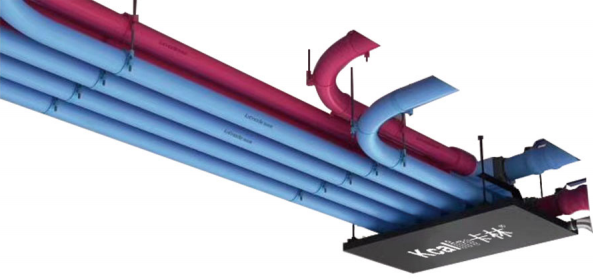With the continuous development and progress of society, there is an increasing global focus on sustainable development and energy efficiency. In this context, various industries are searching for ways to reduce energy consumption and reduce negative impacts on the environment. As one of the important energy consumers in the construction and industrial fields, improving the energy efficiency of ventilation systems has become an urgent task.
Ventilation systems are a crucial part of buildings, industrial plants, and other facilities, designed to provide fresh air, control temperature and humidity, and eliminate pollutants and harmful gases. However, the energy consumption of ventilation systems is high, especially in industrial and commercial buildings, where ventilation systems can account for a significant portion of the overall energy consumption.
The following are some of the main aspects of energy challenges in ventilation systems:
Power consumption: Ventilation systems typically require a large amount of electricity to drive fans, cooling equipment, and heating elements to ensure air quality and comfort.
Operating time: Ventilation systems typically require 24-hour operation, especially in industrial production environments. This means that they consume a large amount of energy.
Variable load: The load of the ventilation system will vary with seasons, weather, and building usage. This requires adjusting the operation of the ventilation system according to different situations to ensure efficiency.
Equipment aging: Many ventilation system equipment is aging and inefficient, requiring maintenance or replacement to reduce energy waste.

SAP is a global enterprise software company that provides a range of business management and analysis solutions. The SAP system is widely used in various industries, including manufacturing, retail, finance, logistics, and so on. Its core functions include enterprise resource planning (ERP), supply chain management, customer relationship management, data analysis and reporting, and so on.
Introducing the SAP system into the management and operation of ventilation systems can provide significant benefits in multiple aspects, especially in energy management:
Real time monitoring and data analysis: The SAP system can be integrated with the ventilation system to monitor and record the performance data of the ventilation system in real time, such as power consumption, temperature, humidity, etc. These data can be used to analyze the operation of the ventilation system and identify potential problems and improvement opportunities.
Energy consumption analysis: The SAP system can analyze the energy consumption patterns of ventilation systems and identify areas of energy waste or low efficiency. This helps managers take targeted measures to reduce energy consumption, such as adjusting the operating time of ventilation systems or setting temperature and humidity control strategies.
Load management: The SAP system can manage the load of the ventilation system based on building usage and seasonal changes. It can automatically adjust the operation of the ventilation system to adapt to different load demands, thereby improving efficiency.
Predictive maintenance: The SAP system can use sensors and data analysis to monitor the status of ventilation system equipment. This helps predict equipment failures and perform preventive maintenance to reduce downtime and repair costs.
Cost control: By monitoring and analyzing the energy consumption and operation and maintenance costs of the ventilation system, the SAP system can help organizations better control the operating costs of the ventilation system.
Under the current strong global attention to energy efficiency and sustainable development, energy management of ventilation systems has become a crucial task. As a comprehensive enterprise management solution, SAP system can play an important role in ventilation systems, achieving optimization and reduction of energy consumption. Through real-time monitoring, data analysis, automated control, and predictive maintenance, the SAP system provides organizations with a powerful tool to address the energy challenges of ventilation systems, reduce costs, improve efficiency, and reduce adverse environmental impacts. Although introducing the SAP system may require some investment and technical support, its long-term economic and environmental returns will be significant. Therefore, for organizations seeking to improve the energy efficiency of ventilation systems, the SAP system is a key tool worth considering.







Comment